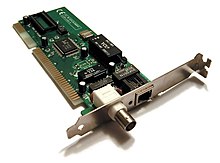Network card

|
|
| Connects to |
Motherboard via one of: Network via one of: |
|---|---|
| Speeds | 10 Mbit/s 100 Mbit/s 1 Gbit/s 10 Gbit/s up to 160 Gbit/s |
| Common manufacturers |
Intel Realtek Broadcom (includes former Avago, Emulex) Marvell Technology Group Cavium (formerly QLogic) Mellanox Chelsio |
Motherboard via one of:
Network via one of:
A network interface controller (NIC, also known as a network interface card, network adapter, LAN adapter or physical network interface, and by similar terms) is a computer hardware component that connects a computer to a computer network.
Early network interface controllers were commonly implemented on expansion cards that plugged into a computer bus. The low cost and ubiquity of the Ethernet standard means that most newer computers have a network interface built into the motherboard.
Modern network interface controllers offer advanced features such as interrupt and DMA interfaces to the host processors, support for multiple receive and transmit queues, partitioning into multiple logical interfaces, and on-controller network traffic processing such as the TCP offload engine.
The network controller implements the electronic circuitry required to communicate using a specific physical layer and data link layer standard such as Ethernet, Fibre Channel, Wi-Fi or Token Ring. This provides a base for a full network , allowing communication among small groups of computers on the same local area network (LAN) and large-scale network communications through routable protocols, such as (IP).
The NIC allows computers to communicate over a computer network, either by using cables or wirelessly. The NIC is both a physical layer and data link layer device, as it provides physical access to a networking medium and, for IEEE 802 and similar networks, provides a low-level addressing system through the use of MAC addresses that are uniquely assigned to network interfaces.
...
Wikipedia
